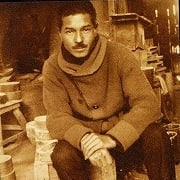Tomimoto Kenkichi
 From Wikipedia - Reading time: 6 min
From Wikipedia - Reading time: 6 min

Tomimoto Kenkichi (富本憲吉, June 5, 1886 – June 8, 1963) was a Japanese potter and a Living National Treasure.
Biography
[edit]His family came from Nara prefecture.
He received a commission to design a large Japanese-lacquered zelkova shelf called “kingin-sai kazari tsubo” for the Ume-no-Ma audience room of Tokyo Imperial Palace.[1]
In November 1914, Tomimoto married Otake Kazue (also known as 'Kokichi'), a niece of the artist Otake Chikuha. Kazue was at one time a member of the feminist literary group Seito (publishers of the magazine of the same name, Bluestocking). A controversial figure in her youth, Kazue had a close relationship (and, it was thought, an infatuation) with Raicho Hiratsuka. It is thought that Tomimoto may have drawn an early draft of the woodblock print which Otake finished and submitted to Seito, which appeared as the cover of the 1913 New Year's issue of Seito magazine.[2]
After marrying, the couple moved to Nara, Japan. Tomimoto and Kazue had three children together, but later separated.[3]
Honors
[edit]He was a recipient of the Order of Culture. He was also named a Living National Treasure.
The Tomimoto Kenkichi Memorial Museum was opened in 1974 in Ando, Nara. His work is also kept in several other museums worldwide, including the Gifu Prefectural Ceramics Museum,[4] the Ohara Museum of Art,[5] the Museum of Ceramic Art, Hyogo,[6] the Museum of Fine Arts, Boston,[7] the Cleveland Museum of Art,[8] the University of Michigan Museum of Art,[9] the Museum of Modern Art, Kamakura & Hayama,[10] the Brooklyn Museum,[11] the National Museum of Modern Art, Tokyo,[12] the National Museum of Modern Art, Kyoto,[13] the Asahi Beer Oyamazaki Villa Museum of Art,[14] the Museum of New Zealand,[15] the Artizon Museum,[16] the Victoria and Albert Museum,[17] and the National Museum of Asian Art.[18]
See also
[edit]References
[edit]- ^ "The Imperial Palace: Photo - The Imperial Household Agency". www.kunaicho.go.jp. Retrieved 2019-07-21.
- ^ Raicho Hiratsuka (trans. Teruko Craig), In the Beginning, Woman Was the Sun – The Autobiography of a Japanese Feminist(『元始、女性は太陽であった』, Genshi, josei wa taiyō de atta),pp.186, 205
- ^ Raicho Hiratsuka (trans. Teruko Craig), In the Beginning, Woman Was the Sun – The Autobiography of a Japanese Feminist(『元始、女性は太陽であった』, Genshi, josei wa taiyō de atta),pp.217, 324
- ^ Jones, Meghen; Cort, Louise Allison (2019-10-16). Ceramics and Modernity in Japan. Routledge. ISBN 978-0-429-63199-3.
- ^ "FACILITY | OHARA MUSEUM of ART". 2016-11-11. Retrieved 2021-01-13.
- ^ "Collections | The Museum of Ceramic Art, Hyogo". www.mcart.jp. Retrieved 2021-01-13.
- ^ "Bowl with decoration of a moth". collections.mfa.org. Retrieved 2021-01-13.
- ^ "Brush Pot with Carved Panels of Prunus Design and Japanese Characters". 31 October 2018.
- ^ "Exchange: Plate with painted design of a covered jar, 'Fragrant Orchid'". exchange.umma.umich.edu. Retrieved 2021-01-13.
- ^ "Work / Material Details : The Museum of Modern Art, Kamakura&Hayama". www.moma.pref.kanagawa.jp. Retrieved 2021-01-13.
- ^ "Brooklyn Museum". www.brooklynmuseum.org. Retrieved 2021-01-13.
- ^ "The Independent Administrative Institution National Museum of Art - Collections". search.artmuseums.go.jp. Retrieved 2021-01-13.
- ^ "The Independent Administrative Institution National Museum of Art - Collections". search.artmuseums.go.jp. Retrieved 2021-01-13.
- ^ "Kenkichi Tomimoto, Bowl, porcelain, wax resist of hop motifs|Collections|Asahi Beer Oyamazaki Villa Museum of Art". www.asahibeer-oyamazaki.com. Retrieved 2021-01-13.
- ^ "Loading... | Collections Online - Museum of New Zealand Te Papa Tongarewa". collections.tepapa.govt.nz. Retrieved 2021-01-13.
- ^ "Collection Highlights". Artizon Museum. Retrieved 2021-01-13.
- ^ "Bowl | Tomimoto, Kenkichi | V&A Search the Collections". V and A Collections. 2021-01-13. Retrieved 2021-01-13.
- ^ "Tomimoto Kenkichi". Freer Gallery of Art & Arthur M. Sackler Gallery. Retrieved 2021-01-13.
External links
[edit]
 KSF
KSF